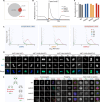Identification and characterization of the de novo methyltransferases for eukaryotic N6-methyladenine (6mA)
- PMID: 40367178
- PMCID: PMC12077518
- DOI: 10.1126/sciadv.adq4623
Identification and characterization of the de novo methyltransferases for eukaryotic N6-methyladenine (6mA)
Abstract
N6-methyladenine (6mA) is an intensively investigated epigenetic modification in eukaryotes. 6mA is maintained through semiconservative transmission during DNA replication, but the identity of de novo methyltransferase (MTase) catalyzing its establishment remains unknown. Here, we identified MT-A70 family proteins AMT2 and AMT5 as the de novo MTases responsible for 6mA establishment, using the unique sexual reproduction process of the unicellular eukaryote Tetrahymena thermophila. Deletion of AMT2 and AMT5 led to a substantial decrease in 6mA levels in the progeny macronucleus, resulting in an altered gene expression pattern and a substantial decline in the survival rate of sexual progenies. Additionally, the maintenance MTase AMT1 could exhibit a much diminished de novo methylation activity in cells lacking AMT2 and AMT5. Our study delineated the establishment-maintenance pathway of 6mA and underscored the biological importance of de novo methylation, revealing a notable parallel between 6mA and the classical 5-methylcytosine in eukaryotes.
Figures







Similar articles
-
Case Study of the Response of N6-Methyladenine DNA Modification to Environmental Stressors in the Unicellular Eukaryote Tetrahymena thermophila.mSphere. 2021 Jun 30;6(3):e0120820. doi: 10.1128/mSphere.01208-20. Epub 2021 May 28. mSphere. 2021. PMID: 34047647 Free PMC article.
-
Semiconservative transmission of DNA N 6-adenine methylation in a unicellular eukaryote.Genome Res. 2024 Jun 25;34(5):740-756. doi: 10.1101/gr.277843.123. Genome Res. 2024. PMID: 38744529 Free PMC article.
-
Methyl-dependent auto-regulation of the DNA N6-adenine methyltransferase AMT1 in the unicellular eukaryote Tetrahymena thermophila.Nucleic Acids Res. 2025 Jan 24;53(3):gkaf022. doi: 10.1093/nar/gkaf022. Nucleic Acids Res. 2025. PMID: 39868535 Free PMC article.
-
N6-methyladenine DNA modification in the unicellular eukaryotic organism Tetrahymena thermophila.Eur J Protistol. 2017 Apr;58:94-102. doi: 10.1016/j.ejop.2016.12.003. Epub 2016 Dec 23. Eur J Protistol. 2017. PMID: 28135687 Review.
-
The epigenetic roles of DNA N6-Methyladenine (6mA) modification in eukaryotes.Cancer Lett. 2020 Dec 1;494:40-46. doi: 10.1016/j.canlet.2020.08.025. Epub 2020 Aug 23. Cancer Lett. 2020. PMID: 32846189 Review.
References
-
- Zhang G., Huang H., Liu D., Cheng Y., Liu X., Zhang W., Yin R., Zhang D., Zhang P., Liu J., Li C., Liu B., Luo Y., Zhu Y., Zhang N., He S., He C., Wang H., Chen D., N6-methyladenine DNA modification in Drosophila. Cell 161, 893–906 (2015). - PubMed
MeSH terms
Substances
LinkOut - more resources
Full Text Sources

